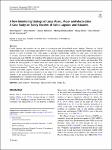Thông tin tài liệu
Thông tin siêu dữ liệu biểu ghi
| Trường DC | Giá trị | Ngôn ngữ |
|---|---|---|
| dc.contributor.author | Gyraite, Greta | - |
| dc.contributor.author | Haseler, Mirco | - |
| dc.contributor.author | Balčiūnas, Arūnas | - |
| dc.date.accessioned | 2023-08-07T04:49:37Z | - |
| dc.date.available | 2023-08-07T04:49:37Z | - |
| dc.date.issued | 2023 | - |
| dc.identifier.uri | https://link.springer.com/article/10.1007/s00267-022-01755-z | - |
| dc.identifier.uri | https://dlib.phenikaa-uni.edu.vn/handle/PNK/8717 | - |
| dc.description | CC-BY | vi |
| dc.description.abstract | Coastal lagoons and estuaries are hot spots to accumulate river basin-related plastic leakage. However, no official methodology exists to investigate their relatively short, rich in organic matter beaches, and the knowledge of pollution of lagoons is scarce worldwide. This study aimed to develop a methodology suitable for large micro (2–5 mm), meso (5–25 mm), and macro-litter (>25 mm) monitoring at sandy inner-coastal waters that would provide comparable results to the intensively used OSPAR 100 m method. The method proposed in this study is based on two 40 m2 rectangular polygons placed on the tidal accumulation zone for macro-litter enumeration and two 1 m2 squares for micro- and meso-litter. | vi |
| dc.language.iso | en | vi |
| dc.publisher | Springer | vi |
| dc.subject | river basin-related plastic leakage | vi |
| dc.subject | Monitoring Strategy | vi |
| dc.title | A New Monitoring Strategy of Large Micro-, Meso- and Macro-Litter: A Case Study on Sandy Beaches of Baltic Lagoons and Estuaries | vi |
| dc.type | Book | vi |
| Bộ sưu tập | ||
| OER - Khoa học môi trường | ||
Danh sách tệp tin đính kèm:

